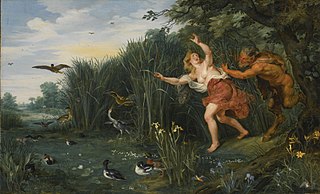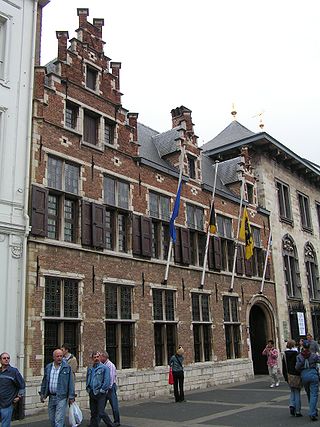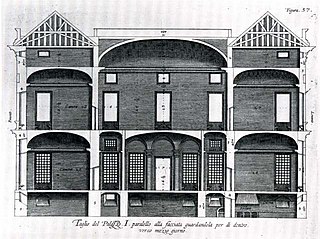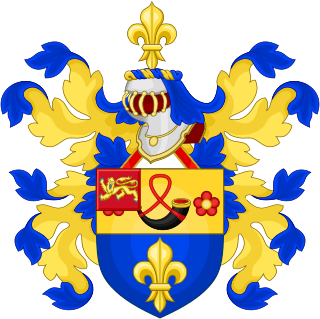Related Research Articles

Jan Brueghelthe Younger was a Flemish Baroque painter. He was the son of Jan Brueghel the Elder, and grandson of Pieter Bruegel the Elder, both prominent painters who contributed respectively to the development of Renaissance and Baroque painting in the Habsburg Netherlands. Taking over his father's workshop at an early age, he largely painted the same subjects as his father in a style which was similar to that of his father. He gradually was able to break away from his father's style by developing a broader, more painterly, and less structured manner of painting. He regularly collaborated with leading Flemish painters of his time.

The Massacre of the Innocents is the subject of two paintings by Peter Paul Rubens depicting the episode of the biblical Massacre of the Innocents of Bethlehem, as related in the Gospel of Matthew (2:13–18). The first, measuring 142 x 182 cm, was painted after his return to his native Antwerp in 1608, following eight years spent in Italy.

Frans Francken the Younger was a Flemish painter and the best-known and most prolific member of the large Francken family of artists. He painted large altarpieces for churches as well as smaller historical, mythological and allegorical scenes. His depictions of collectors' cabinets established a popular new genre of art in the era. Francken often collaborated with other artists, adding figures and narrative elements to scenes created by specialists in landscape, architectural and floral still life paintings.

The Rubenshuis is the former home and workshop of Peter Paul Rubens (1577–1640) in Antwerp. Purchased in 1610, Rubens had the Flemish townhouse renovated and extended on the basis of designs by Rubens himself. After the renovations, the house and its courtyard garden had the outlook of an Italian palazzo, which reflected the artistic ideals of Rubens. The ensemble is now a museum dedicated mainly to the work of Rubens and his contemporaries.

Sir Peter Paul Rubens was a Flemish artist and diplomat. He is considered the most influential artist of the Flemish Baroque tradition. Rubens's highly charged compositions reference erudite aspects of classical and Christian history. His unique and immensely popular Baroque style emphasized movement, colour, and sensuality, which followed the immediate, dramatic artistic style promoted in the Counter-Reformation. Rubens was a painter producing altarpieces, portraits, landscapes, and history paintings of mythological and allegorical subjects. He was also a prolific designer of cartoons for the Flemish tapestry workshops and of frontispieces for the publishers in Antwerp.

Justus van Egmont or Joost van Egmont was a painter and a tapestry designer during the 17th century. After training in Antwerp with Gaspar van den Hoecke and working with Anthony van Dyck, van Egmont also worked in Peter Paul Rubens' workshop. He moved to France in 1628 where he was a court painter for the House of Orléans. In France he helped to found the Académie de peinture et de sculpture. He later returned to Flanders where he worked in Antwerp and Brussels. He is mainly known for his portrait paintings, although he also painted some history subjects, and produced designs for five different tapestry series.

Cornelis van der Geest was a spice merchant from Antwerp, who used his wealth to support the Antwerp artists and to establish his art collection. He was also the dean of the haberdashers guild.

Pronkstilleven is a style of ornate still life painting, which was developed in the 1640s in Antwerp from where it spread quickly to the Dutch Republic.
Despite its size, Belgium has a long and distinguished artistic tradition that goes back to the Middle Ages, considerably pre-dating the foundation of the current state in 1830. Art from the areas making up modern Belgium is called in English Netherlandish up to the separation with the Netherlands from 1570 on, and Flemish until the 18th century.

Palazzi di Genova is a 1622 book written and illustrated by Peter Paul Rubens, depicting and describing the palaces of Genoa, Italy in 72 plates. A second volume with 67 further plates was added the same year, and they are usually found together. The illustrations of the second part are usually considered not to be by Rubens though. It is the only book Rubens published himself.

Portrait of a Commander or A Commander Being Dressed for Battle is a portrait of an unknown man in plate armour, by Peter Paul Rubens. In July 2010 it was sold for £9 million by Christie's after Sotheby's turned it down, suspecting its authenticity as a Rubens. In December 2011, the portrait was placed on loan with the Metropolitan Museum of Art in New York.

Bendor Gerard Robert Grosvenor is a British art historian, writer and former art dealer. He is known for discovering a number of important lost artworks by Old Master artists, including Sir Peter Paul Rubens, Claude Lorrain and Peter Brueghel the Younger. As a dealer he specialised in Old Masters, with a particular interest in Anthony van Dyck.

The Recollects Convent (Minderbroederskerk) was a monastery of the Recollects order in Antwerp in Belgium. It was the original location of several works by Peter Paul Rubens and Anthony van Dyck (Deposition). It was also the first home of the Royal Museum of Fine Arts until 1875, when the town council decided to rehouse it in a new purpose-built building.

The Rubens family is a Flemish noble family that lived in Antwerp.

The "lost portrait" of George Villiers, 1st Duke of Buckingham is a portrait of English courtier George Villiers, 1st Duke of Buckingham. It was painted around 1625 by Flemish artist Peter Paul Rubens.
Elizabeth McGrath, is a British art historian, curator, and academic. Spending all of her career at the Warburg Institute of the University of London, she was curator of the photographic collection from 1991 to 2010 and Professor of the History of Art from 2000 to 2010. She additionally held the Slade Professorship of Fine Art at the University of Oxford from 1989 to 1990. Since her retirement in 2010, she has been Emeritus Professor and an honorary fellow of the Warburg Institute.
Hans Nieuwdorp is a Belgian art historian specialized in late medieval sculpture. In 2000, he was appointed director of the Art Museums of the City of Antwerp.

The Phoebus Foundation is an art foundation with philanthropic objectives. The foundation acquires works of art, guarantees a professional framework of conservation and management, and looks after the conservation and restoration of the objects. In doing so, it focuses on scientific research. It shares the results of this all with the widest possible audience, through exhibitions, cultural expeditions, symposiums and publications.

The Apostle Matthew is a c. 1618-1620 painting by the Flemish artist Anthony van Dyck depicting Matthew the Apostle. One of its inspirations was probably the series of paintings of the Apostles he had seen in his master Rubens' studio around 1610, produced for the Duke of Lerma. The smooth brushwork is consistent with the painter's other works from first period in Antwerp.

The Story of Caesar and Cleopatra is an amalgamation of fourteen tapestries put together by the Art Institute of Chicago from three separate tapestry series in their collection. The original tapestry series' were the Story of Caesar Augustus, the Story of Cleopatra, sometimes referred to as the Story of Cleopatra and Antony, and the Story of Zenobia and Aurelian, all designed by Justus van Egmont in the 17th century. The tapestries were made in the Flemish High Baroque style. They were produced by some of the leading weaving workshops of the time and were commercially successful.
References
- ↑ "Ben van Beneden -". CODART. Retrieved 2017-10-01.
- ↑ "Rubens in Private – an interview with Ben van Beneden, director of Rubenshuis Antwerp". www.artdependence.com. Retrieved 2017-10-01.
- ↑ "BBC - BBC Four's Britain's Lost Masterpieces discovers a missing Rubens masterpiece - Media Centre". www.bbc.co.uk. Retrieved 2017-10-01.
- ↑ "Ben van Beneden". thamesandhudson.com. Retrieved 2017-10-01.
- ↑ "Ben van Beneden". CODART. Retrieved 2024-02-29.